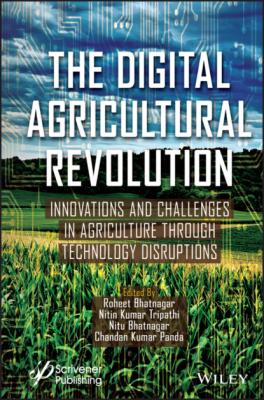ТОП просматриваемых книг сайта:
The Digital Agricultural Revolution. Группа авторов
Читать онлайн.Название The Digital Agricultural Revolution
Год выпуска 0
isbn 9781119823445
Автор произведения Группа авторов
Жанр Программы
Издательство John Wiley & Sons Limited
2.4 Importance of Remote Sensing in Crop Yield Estimation
As remote sensing provides up-to-date, precise, and cost-effective information, remote sensing and GIS support agricultural production monitoring toward sustainable agricultural systems. The application of remote sensing technology agricultural operations requires high accuracy and reliable data with data quantitative processing facility [52]. For crop yield prediction, very highly accurate and reliable data are necessary. It was clear from the studies that even after a long time of research (more than 20 years), no regular crop yield estimation method suitable for a wide range crops was developed; however, a huge amount of work done was shown and is an important step in this field.
Remote sensing imageries have the potential to provide spatial information of features at any scale on earth at real-time basis. Remote sensing imageries have the potential not only in identification of crop classes but also in estimation of crop yield. A wide number of sensors data is useful for yield estimation of crops. Soil moisture, NDVI, surface temperature and rainfall data were considered for assessment of crop yield, using piecewise linear regression method with breakpoint, found predicted values very close to observed values (R2 = 0.78) for corn and for soybean crop (R2 = 0.86) [53]. Poststratified estimator of crop yield using satellite data (IRS-1B-LISS-II) along with crop yield data from crop cutting experiments for small area estimated crop yield at tehsil/block level with the existing sampling design [54]. A simple linear statistical relationship between normalized difference vegetation index and yield used for estimation of paddy, corn, wheat, and cotton crops was developed [55]. Corn yield scenarios was constructed from the AVHRR-based temperature condition index (TCI) and vegetation condition index (VCI) at approximately 42 days prior to harvest time [56]. Recent studies used low altitude helicopter and unmanned aerial vehicle (UAV) for field scale yield prediction. A study using UAV at 20 m height revealed that NDVI values were highly correlated with yield and total biomassat panicle initiation stage [57].
Although a large amount of research has been done on this, there is no particular best yield estimation method available [58, 59]. Training of neural network with RS data can be done to predict crop yield. It is also possible with big satellite data analytics also with neural network.
2.5 Derivation of Crop-Sensitive Parameters From Remote Sensing for Paddy and Sugarcane Crops
2.5.1 Study Area
The present study was carried out in Krishna Central Delta (KCD), a part of Krishna Eastern Delta in the Krishna district in the state of Andhra Pradesh, which is named after the holy river Krishna, bounded by the latitudes 16°37'15"N and 15°42'15"N and longitudes 80°34'0"E and 81°16'0"E. It constitutes the command area of Bandar canal and Krishna Eastern bank canal, which has an irrigated ayacut of 111223.83 ha in Krishna district. It irrigates about 18 mandals in Krishna district (Figure 2.2). In the Kharif season (July/August to November/December), the major crops grown are paddy, sugarcane, turmeric, and vegetables, and the predominant crops grown during the Rabi season (December to March) are paddy, sugarcane, maize, pulses, and cauliflower. At the upper reaches, farmers are also cultivating in the summer season. Orchards are also grown specifically in south part of the study area. The main crop in Kharif is paddy in 95% of the study area. The various land use pattern of the study area is presented in Table 2.1. The major area is under agriculture (1539.342 km2) followed by aqua (402.971 km2) and horticulture (57.648 km2).
Figure 2.2 Location details of Krishna Central Delta (original figure).
Table 2.1 Land use of the study area in the year 2014–2015.
| S. no. | LULC class | Area (km2) | Percentage (%) |
|---|---|---|---|
| 1 | Agriculture | 1539.342 | 69.1924 |
| 2 | Water bodies/Aqua | 402.971 | 18.11328 |
| 3 | Other waste land | 18.91 | 0.849992 |
| 4 | Buildup | 117.369 | 5.275659 |
| 5 | Deciduous forest | 88.487 | 3.977432 |
| 6 | Plantation/orchard | 57.648 | 2.591239 |
2.5.2 Materials and Methods
2.5.2.1 Data Acquisition and Crop Parameters Retrieval From Remote Sensing Images
Five RS indices, namely normalized difference vegetation index (NDVI), surface temperature (Ts), water stress index (WSI), absorbed photosynthetically active radiation (APAR), and averaged yield for the last 5 years, were selected. The first four parameters were retrieved from Landsat 8 remote sensing images. The average yield is calculated from statistical and ground truth data.
The spectral information from free available high-resolution optical Landsat 8 satellite images is used in the present study. Several researchers reported that estimates from Landsat were considerably more accurate in yield estimates and its variability during growth stages [60, 61]. The Landsat 8 level 1 images were downloaded from USGS Earth explorer. Digital numbers are changed to TOA reflectance data. The developed indices are as follows.
The NDVI is most important and efficient index of crop growing conditions [62, 63], which is the response index to greenness and vegetative cover High NDVI values that reflect greater greenness, similarly, low NDVI values reflect too stress or senescence and low vegetation. It is the normalized difference between the near infrared (NIR) and visible RED (R) reflectance bands.
(2.1)
The next important parameter is solar radiation. The amount of light available for photosynthesis is known as photosynthetically active radiation (PAR) and ranges between 400 and 700 nanometers. Absorbed photo synthetically active radiation is the portion absorbed for photosynthesis by crop leaves.
(2.2)
Fraction

